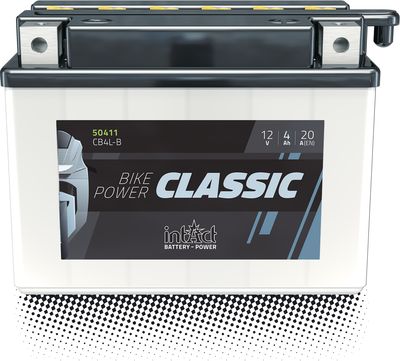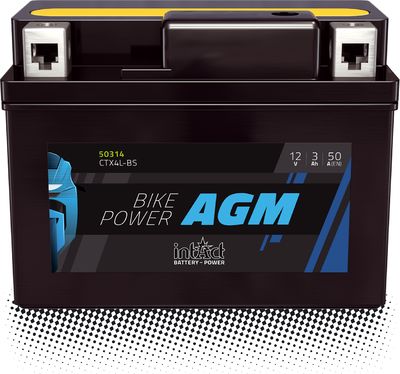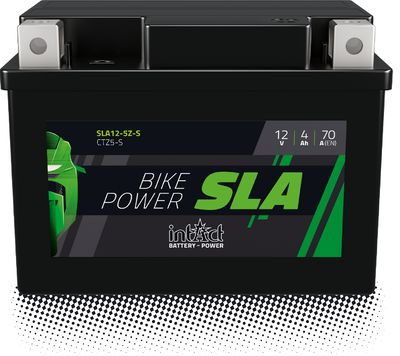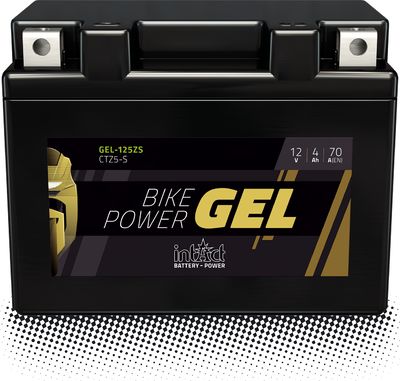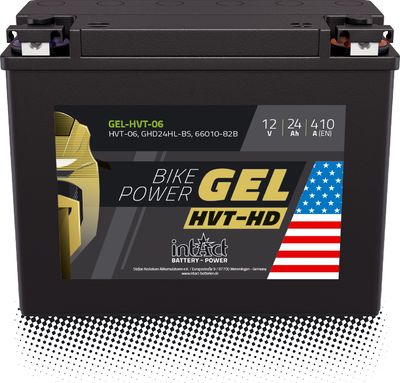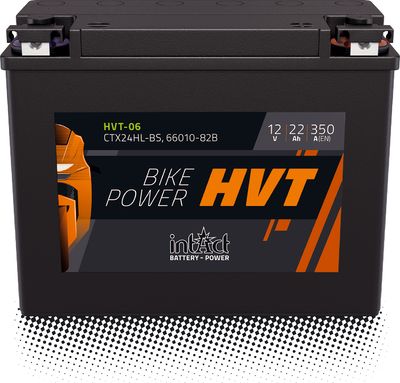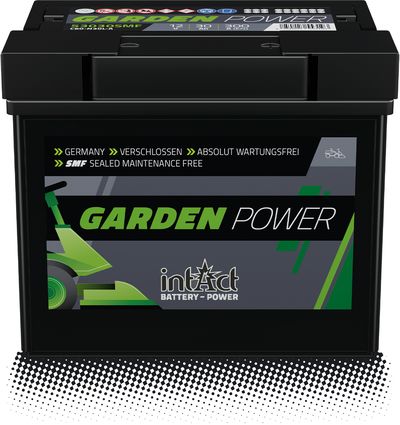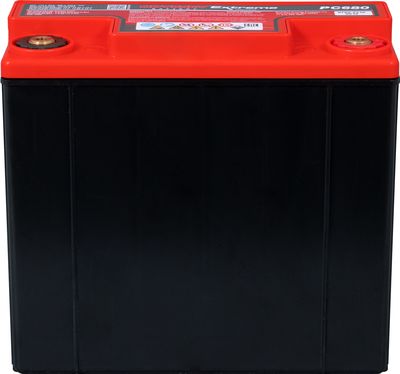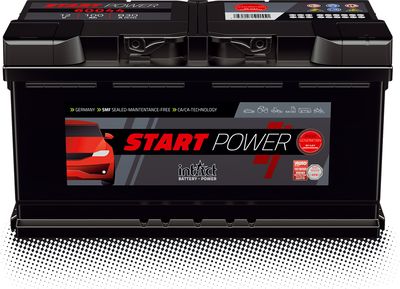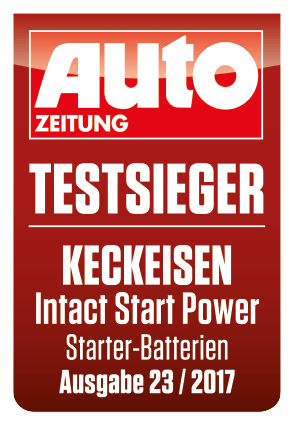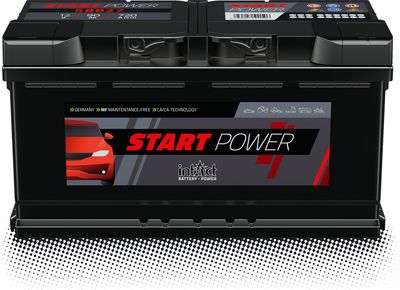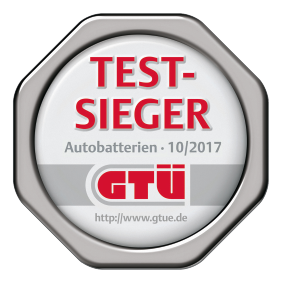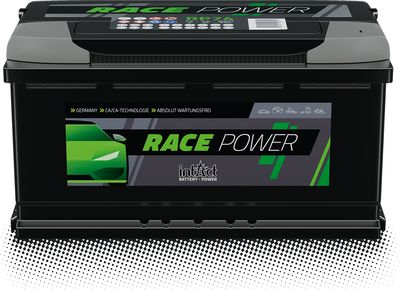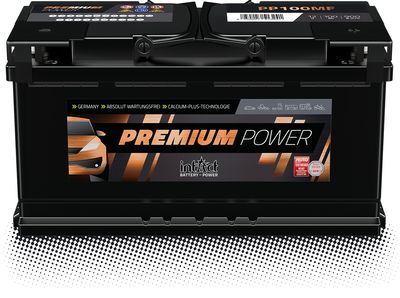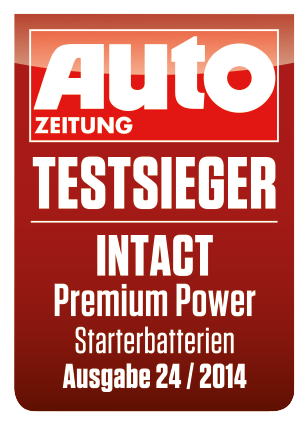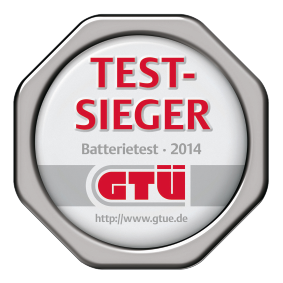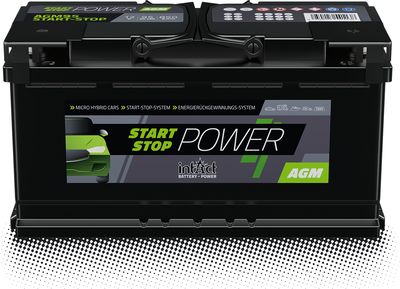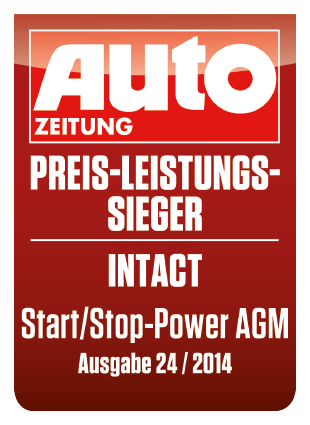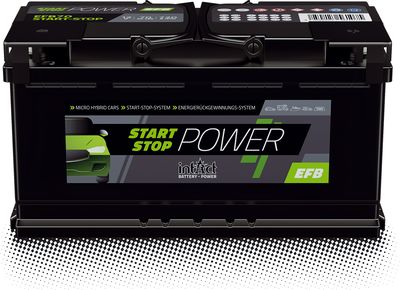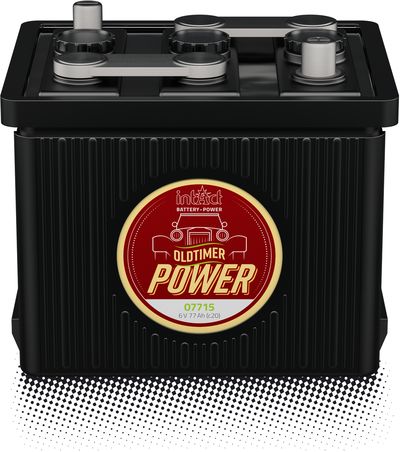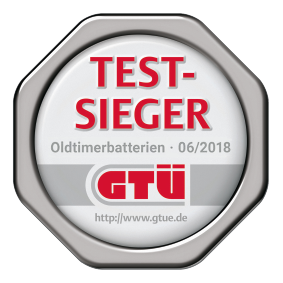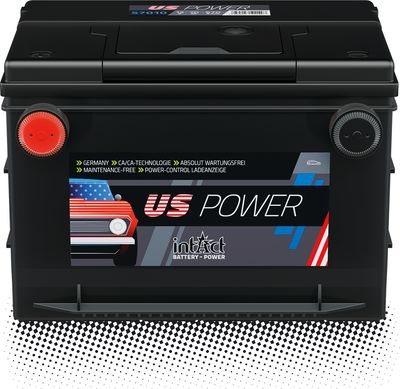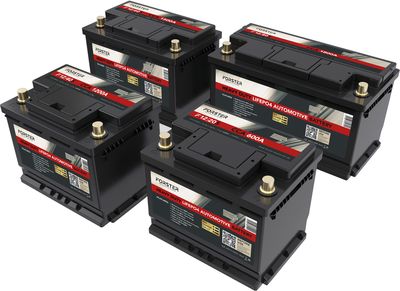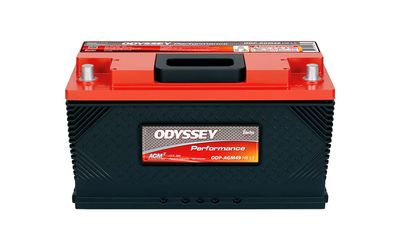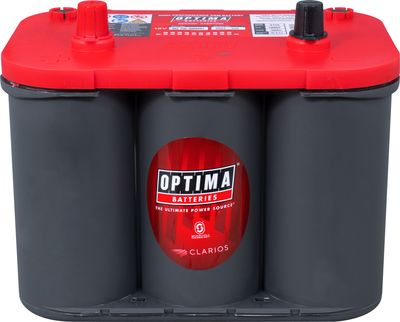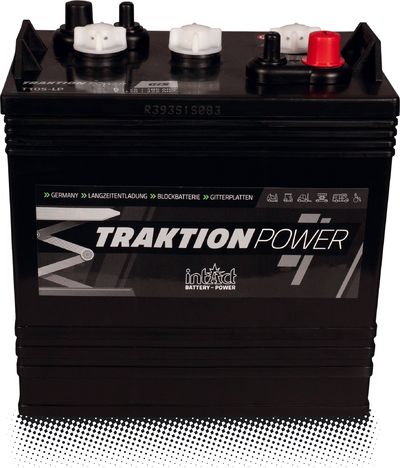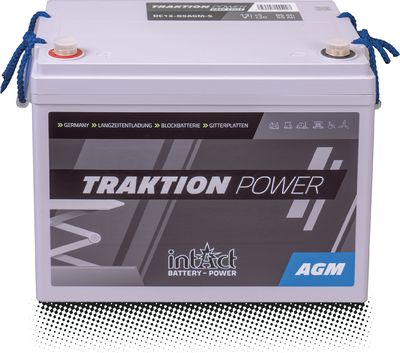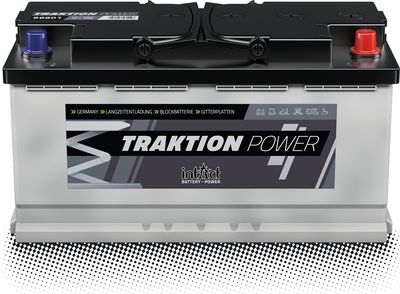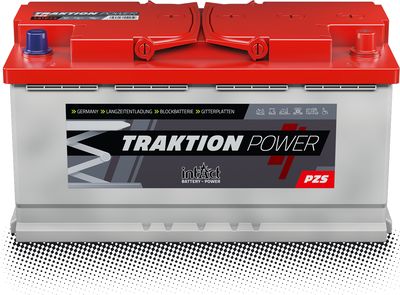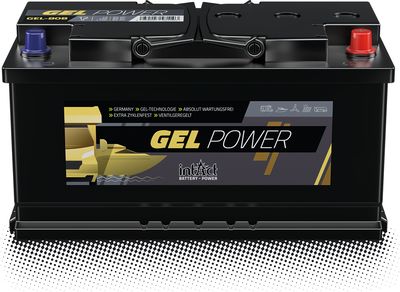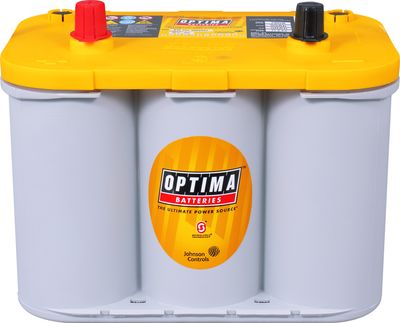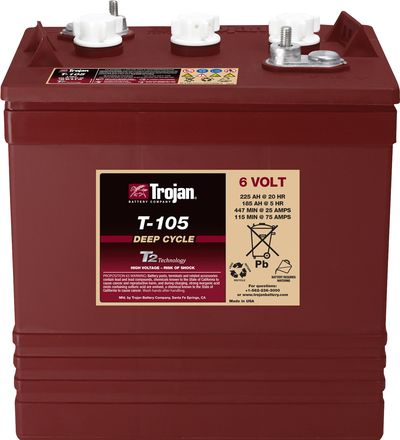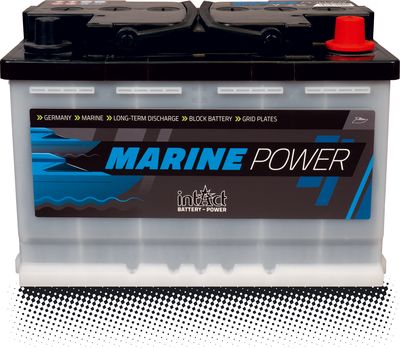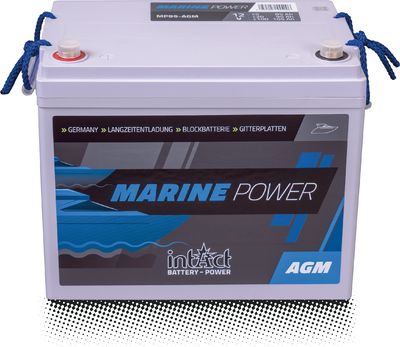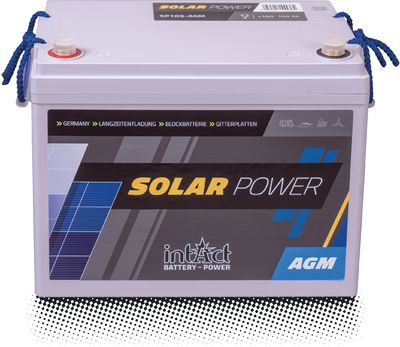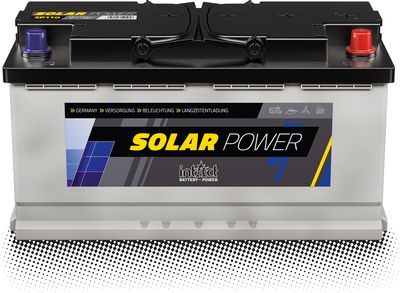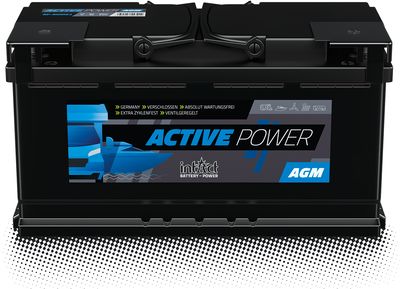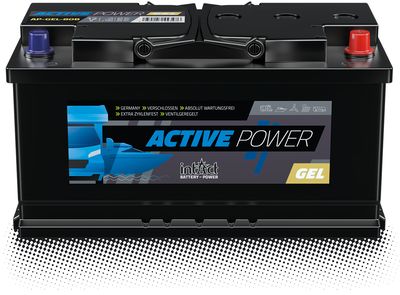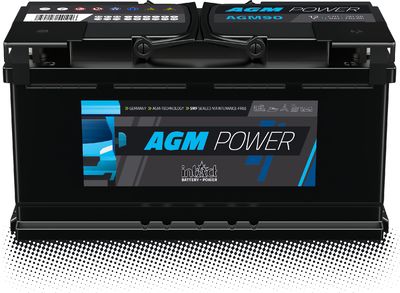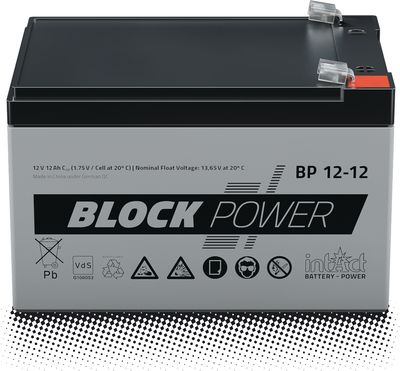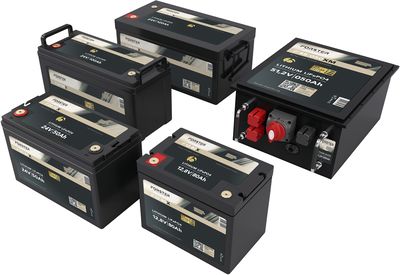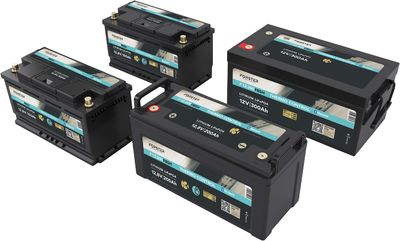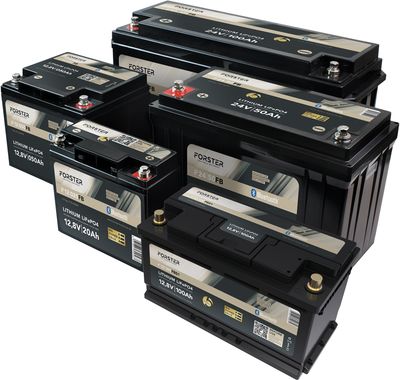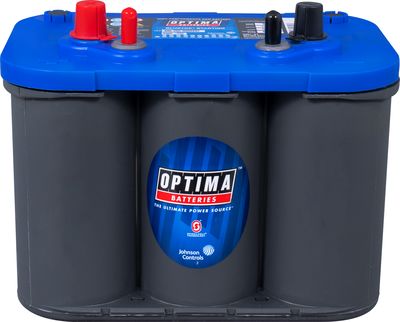FAQ
The intAct Bike-Power AGM is a VRLA battery, i.e. a valve-regulated lead acid battery. The little gas that is produced is returned to the circuit by gas recombination and overpressure is prevented by the safety valve. The usual venting of wet batteries such as the intAct Bike-Power Classic does not take place, so there is no need to discharge gas or vapour from the interior of the vehicle to prevent it from condensing under the trim parts and leading to corrosion.
With dry pre-charged batteries, the acid is not yet filled, but the workshop, customer service or the user must fill it with battery acid and charge it before installation.
With the intAct Bike-Power Classic and the intAct Bike-Power AGM, an acid pack with exactly the right amount of battery acid is supplied.
Due to the AGM technology, this battery absorbs the current particularly well, i.e. it recharges faster than a conventional wet battery and you can charge it with a higher charging current or a more powerful charger, like the ?
This characteristic comes from the fact that in AGM batteries the acid is virtually pressed against the electrodes by the fleece separators. This means that the reaction surface in the battery is larger. This means that more sulphuric acid molecules can react with the active lead sulphate at the same time, which means that more electrons are bound at the same time during charging, i.e. more current is drawn. In addition, the special alloy of the grids conducts the current particularly well.
With many short journeys or long standstill times, the charge level continues to build up. This means that the battery receives less energy from the alternator than it needs for starting. Its charge level gradually drops. Once a battery is discharged to below approx. 50% or approx. 11.8 V, it is unlikely that it can be recharged. To avoid this, we recommend charging regularly with a charger.
intAct Bike-Power AGM, intAct Bike-Power SLA, intAct Bike-Power GEL and intAct Bike-Power HVT are valve regulated lead-acid batteries or VRLA batteries.
VRLA batteries produce much less gas than wet batteries. The gas produced remains in the circuit of the battery due to gas recombination, excess pressure is prevented by a safety valve. These batteries lose significantly less liquid. They do not need to be topped up, and it is not even possible to do so, as they cannot be reopened without damage.
Both the intAct Bike-Power GEL and the two AGM technology based batteries intAct Bike-Power SLA and the intAct Bike-Power HVT are delivered already filled and charged. They are absolutely maintenance-free.
With the intAct Bike-Power AGM no maintenance is possible and necessary after the first filling. It is maintenance-free.
A high cold start power ensures that a motorcycle will still start even if the battery is not fully charged. This can happen if the battery discharges during idle times, e.g. on motorcycles, ride-on lawnmowers or snowmobiles that are only used seasonally. Or even if the battery is only charged for a very short time during very short driving distances before having to restart the motorcycle.
The cold start power gives information about the power that a battery can provide quickly. In AGM batteries, the acid is virtually pressed against the electrodes by the fleece separators. This means that the reaction surface in the battery is larger. This means that more sulfuric acid molecules can react with the active lead sulfate at the same time, which simultaneously releases more electrons, i.e. more current is delivered. The alloy of the grids is also designed so that the current is conducted quickly to the consumers.
Due to these specific properties, the current is still sufficient for starting even when partially discharged. The same properties also ensure that the current is absorbed better, so that the battery charges faster, e.g. even over short distances.
A battery that primarily starts the motorcycle. For this, the starter motor needs a lot of power for a short time. Important for this is the cold start power (CCA) that the battery provides, but also the characteristics. A battery with a high current reserve will start the motorcycle even partially charged, for example.
In addition, the motorcycle battery supplies the electrical consumers, since it is the only battery in the motorcycle. The more consumers are installed, especially retrofitted safety or entertainment features, the more capacity is needed so that the consumers are also supplied at idle or when the engine is off or the machine still starts after the consumers have been used.
A battery that is charged by the alternator and starts the vehicle. For this purpose, the starter motor requires a lot of current for a short time. In addition to the cold start capacity (CCA), which indicates how much current the battery can ideally supply, the properties of a battery influence how reliably it can provide this starting power. A battery with very good charging properties recharges more quickly, for example, which benefits vehicles in city traffic in particular. It also supplies the consumers in vehicles without an additional back-up battery or supply battery. The more electrical consumers are installed at the factory or retrofitted, the more capacity is required to supply them when the vehicle is idling or at an engine stop and still reliably restart the vehicle.
Traction batteries supply power to the electric motor in machines and vehicles. They are designed to be charged with a charger when not in use and then discharged when in use. Traction batteries are designed for this repetitive alternation between charging and discharging or cycling. Unlike starter batteries, they tolerate being repeatedly discharged to a depth of discharge of up to 80 % well due to the special composition and construction of the grids and separators. The cycle stability of a traction battery provides information on how often it can reach this depth of discharge under ideal circumstances before it is damaged.
Supply batteries must provide power for as long as possible for consumers that are not connected to the regular power grid or the starter battery. Either in mobile applications, e.g. camping or in island installations such as mountain huts, or in safety applications when the normal power grid fails or to compensate for so-called mains wipers. Depending on the application, they are charged with a charger from the mains or via smaller photovoltaic or wind power systems.
So not only do they have to supply power for a long time and then take it up again well, but they also have to cope well with changing current levels and voltages.
Supply batteries are cyclic batteries, i.e. they are designed to continuously deliver current up to a maximum depth of discharge of 80% when supplying electrical consumers and then to be fully recharged again. In contrast, a starter battery delivers a short, strong current surge for starting the engine and is recharged by the alternator while driving.
For normal passenger cars, also US vehicles, Asian models and classic cars, mostly modern, maintenance-free flooded batteries are used, such as the intAct Start-Power NG, the intAct Race-Power or the intAct Premium-Power.
These batteries are suitable for small cars, SUVs, jeeps, all-wheel drive vehicles, minivans, vans and many more.
If a back-up battery is provided in the car, AGM batteries such as our intAct Back-Up-Power are used for this purpose.
In vehicles with a lot of consumers, dual-purpose batteries like the Optima Redtop or the Odyssey starter batteries can be a good solution. Thanks to AGM technology with pure lead grids, they reliably supply power-hungry consumers and still start with high performance. This also makes them well suited for use in buses, motorhomes or boats in which no additional supply battery is installed.
The EFB (Enhanced Flooded Battery) was developed for start-stop vehicles. This further development of the wet battery is significantly more cycle resistant, like the intAct Start-Stop-Power EFB. Because of the good current reserve, AGM batteries are also used here, like the intAct Start-Stop-Power AGM.
Start-stop batteries are suitable for micro-hybrids with brake energy recovery/recuperation, taxis, boats and many more.
Batteries in trucks, commercial vehicles, agricultural machines and buses have to be vibration resistant due to engine vibrations. Our truck batteries in SHD versions are vibration resistant according to V3, like intAct Start-Power NG Truck, or V4, like intAct Premium-Power Truck. For trucks with start-stop function EFB batteries are suitable, like the intAct Start-Stop-Power EFB Truck. They also cope well with the increased power consumption due to living in the driver's cab.
Truck batteries are suitable for agricultural machinery, construction vehicles, trucks, tractors, buses, coaches, emergency vehicles and much more.
In some cars, so many consumers are installed from the outset that it would overload the starter battery to supply them. This is where so-called back-up batteries are used.
If your car is equipped with a back-up battery, you should replace it again with a battery for this purpose, like our intAct Back-Up-Power.
A supply battery used in motorhomes or campers, colloquially known as a camper battery. Typically, it is charged with stationary charging current at the RV parking lot or via a solar system, because the alternator is not sufficient to provide the necessary current.
As batteries can leak gases during normal operation, we recommend not to install the battery in the living area if possible or to use a sealed battery with safety valve, which causes almost no gases, like the intAct Active-Power AGM or the intAct Active-Power GEL. Depending on where the journey is to go, it makes sense to choose a battery that is particularly temperature-resistant, such as the Odyssey supply batteries, which also performs well in heat or cold.
These block batteries ensure the uninterruptible power supply (UPS) of POS systems or smaller computer systems as well as security systems such as locking systems or security lighting when the power grid fails. UPS systems also protect the connected loads from damage or data loss due to mains fluctuations or mains surges. In addition to directly applicable block batteries such as the intAct Block-Power, individually configured battery systems are used for larger systems with high power requirements or special safety requirements. Our industrial division inbatt has the corresponding approval for the high-security area to offer this solution precisely.
Utility batteries, which can be used as temporary storage for photovoltaic (PV) or small wind systems, are highly cycle resistant, meaning they can withstand different charging cycles well. In the renewable energy sector, charging cannot be done with a regular current, but the battery has to absorb the current according to the changing conditions of wind and sun. The intAct Solar-Power is perfectly suitable for intermediate storage in motorhomes and camping areas as well as small island systems in temporary used cabins or holiday homes.
Power storage systems for private households or the commercial sector require larger capacities. We offer correspondingly designed solutions consisting of battery cells and charge controllers through our industrial battery division inbatt.
Black deposits on the plugs indicate a battery that has worn out prematurely due to continuous excessive load.
Tip: Always ensure a good balance between current drain and charging.
Information on capacity calculations and charging behaviour can be found in our Motorcycle batteries, Starter batteries, Drive batteries and Supply batteries.
Whitish-grey deposits on the poles, so-called "pole growth", is caused by strong sulphation on the plates.
Tip: Always ensure a good state of charge.
A melted pole is caused by a short circuit when the battery polarity is reversed during bridging or when the poles are connected by a tool or other object.
Tip: Take care when handling batteries.
Learn more about short circuit and how to avoid it.
A brown-reddish discoloration of the plugs indicates an overcharging of the battery and a fault in the charging system.
Tip: Your workshop can check whether your charge controller is working properly.
Tip: Check the function and characteristics of your charger and, if necessary, replace it with one that supports important safety features such as automatic switch-off, short-circuit protection, reverse polarity protection, etc.
Detached labels indicate wear due to excessive temperatures.
Tip: Always give your battery time to cool down before charging or use a charger that charges temperature compensated.
Tip: If you operate your vehicle or device in a very hot environment, choose a battery that can withstand high temperatures.
Damaged battery box
If the housing is leaking, cracked or chafed, this indicates destruction by external influences.
Tip: Look for a robust design in your next battery.
Deformed battery case
If the housing is deformed by heat, this indicates a defective charge controller or incorrect charger.
Tip: Always choose the right charger for your battery, your intended use and your individual requirements!
Tip: Your workshop can check whether your charge controller is working properly.
Wrinkled battery case
If the case is deformed on a single cell, this is an indication of plate growth due to deep discharge or a cell short circuit.
Tip: Always ensure a good state of charge.
Sulphation or sulphation is an undesirable ageing process in batteries where too much lead sulphate forms on the lead plates, which cannot be removed even with prolonged charging. The battery's capacity drops significantly, or it fails altogether. Sulfation is typical static damage that occurs when a battery is left in a discharged state for too long or is charged incorrectly or too little.
With frequent short distance driving, sulfation builds up and builds up. The small amount of charge during the short journey is not sufficient to reduce the lead sulphate produced during the starting process (=discharging). The decreasing power of the battery also decreases its ability to draw current, i.e. during the next short drive the battery is charged even less, i.e. even less lead sulphate is converted again.
If sulphation is far advanced, there are clearly visible whitish-grey deposits on the poles, the so-called "pole growth".
Prevention
This can be prevented by short-distance drivers using an external charger to ensure that the battery is always sufficiently charged, by fully charging the battery before the winter break and by counteracting self-discharge during standstill periods by regular charging. Modern chargers also allow trickle charging, so that the battery voltage never falls below a certain value.
Some chargers have a desulphation phase in which the lead sulphate is dissolved by short current surges.
Short-circuiting occurs when the two terminals or plates of a battery are accidentally connected together. This can happen if the separator between the plates is damaged by vibration, for example, or if excessive battery sludge builds up, closing the gap between the plates below the separator.
If the case is deformed on a single cell, this is an indication of such cell closure. However, it may also indicate excessive plate growth due to deepest charging.
Prevention
Selecting the battery suitable for the respective use helps in both cases. The intAct Bike-Power HVT is especially compact to protect all components. Cycle-resistant batteries such as the intAct Bike-Power GEL withstand frequent partial discharges well, i.e. they form less battery sludge than other battery classes.
In addition Even when bridging the battery, a short circuit can occur if the polarity is reversed or the two connection poles are accidentally connected by a tool or similar.
A short circuit caused by reversed polarity or accidental connection of the terminals can be recognised by the fact that at least one terminal has melted off.
If your battery is regularly exposed to strong vibrations or shocks, choose a SHD starter battery in future, such as the intAct Premium-Power Truck or the intAct Start-Stop-Power EFB, a HVT motorcycle battery such as the intAct Bike-Power HVT or the intAct Traction-Power PzS or intAct GEL-Power for drive or supply applications.
With a worn battery, the active material has degraded due to excessive load. Modern vehicles with many consumers constantly place higher demands on the battery. The capacity of the installed batteries is often not designed for this.
Prevention
The choice of the right battery plays an important role here. Strong vibrations and high temperatures place additional stress on the active material.
To help you select the right battery for your application and your individual requirements, we have put together some tips for buying batteries.
Simply scroll down under the relevant batteries:
Gases are produced during charging. As they rise, they mix the battery acid.
It is better for the battery if it is open during this process.
Important: This only applies to initial charging and to all batteries that can be opened. Never open a battery by force!
For motorcycles and four-wheeled small vehicles, there are classic flooded batteries in low-maintenance design (intAct Bike-Power Classic and Exide Bike Conventional) or maintenance-free (intAct Garden-Power), AGM batteries (intAct Bike-Power AGM, intAct Bike-Power SLA, Exide Bike AGM and our Odyssey motorcycle batteries), HVT and GEL batteries (intAct Bike-Power HVT, intAct Bike-Power GEL HVT-HD and intAct Bike-Power GEL) and Lithium batteries (intAct Bike-Power Lithium). To cover as many vehicle types as possible, there are batteries in 12-volt as well as 6-volt versions.
Motorcycle batteries are not only used for motorized two-wheelers from classic cars to racing bikes, for scooters, light motorcycles, and mopeds from 50 cc, but also for four-wheeled sports and recreational vehicles and work vehicles with handlebars for any terrain also with all-wheel drive such as ATVs, Quads or with steering wheel like ride-on lawn mowers, for utility vehicles and recreational vehicles with side-by-side seats like UTVs and buggies, for snowmobiles for 1 - 2 persons like snowmobiles, snowmobiles and snow motorcycles as well as for water motorcycles like PWCs, jet boats, jet skis and similar.
In start-stop vehicles, the engine stops every time the vehicle is in neutral. This saves petrol and reduces air pollution. However, this means an extremely high load for the battery.
It has to start much more often, i.e. deliver high currents, than a normal starter battery. At the same time, it has to supply the consumers while the engine stops. Between stops, it only has a short time to recover the necessary current.
Therefore, only start-stop batteries designed for this load may be used in vehicles with start-stop systems. Normal starter batteries would age extremely quickly.
Then the only question left is: Do you need an EFB or AGM start-stop battery?
If an EFB start-stop battery is installed at the factory, it can be replaced again with an EFB start-stop battery. An upgrade to AGM is always possible.
If an AGM start-stop battery is installed at the factory, it may only be replaced with an AGM start-stop battery.
AGM batteries, with their high cold-start performance and good current consumption, are a good basis for start-stop batteries. EFB (Enhanced Flooded Battery) have similar strengths. They have evolved from the conventional flooded battery. A calcium grid alloy ensures better current transport in the cell and a higher cycle stability than in the classic wet battery. More information about the characteristics of the two start-stop types under intAct Start-Stop-Power AGM or intAct Start-Stop-Power EFB.
Especially in trucks and other high-displacement commercial vehicles with diesel engines, there are strong vibrations that cause the battery to age prematurely. Our truck batteries in SHD versions are vibration resistant according to V3, like the intAct Start-Power NG Truck, or V4, like the intAct Premium-Power Truck.
But also in heavy passenger cars like SUVs and off-road vehicles the performance of the battery can suffer from the mechanical vibrations and shocks.
AGM batteries offer a good option here with the glass fibre separators: in the Optima Redtop, the wound plates pressed into the battery housing provide additional protection for the active material, and in the Odyssey starter batteries, the tightly layered, precisely fitted plates made of 99.99 % pure lead.
Another option for both cars and trucks is the intAct Start-Stop-Power EFB (Enhanced Flooded Battery). This further developed flooded battery is also particularly vibration-resistant.
In order to withstand the stress of cyclic operation for a long time without an excessive drop in performance, the active material in supply batteries is particularly well protected.
Depending on the technology used, this is done in different ways:
In supply batteries with tubular or armored plates, the active material is virtually armored in the tubes of the plate, making the intAct Traction-Power PzS suitable for heavy cyclic use up to 1,000 cycles according to IEC 254-1. In supply batteries with grid plates based on GEL, like the intAct GEL-Power, the gel-like fixed electrolyte ensures that the electrolyte is not lost, in AGM batteries like the intAct AGM-Power the separator fleece, which lies tightly against the plates. While the gel-like fixed electrolyte also ensures a permanently uniform current output, the AGM's glass-fibre fleece helps with fast charging and the provision of high charging currents. This effect is further enhanced in dual-purpose AGM-based batteries by providing more grid surface area and thus active material for the reaction, as in the Odyssey utility batteries by thinner plates of 99.99% pure lead and in the Optima Bluetop by winding the plates into tight round cells.
Lithium-based supply batteries have a particularly long service life. Due to the lithium technology there is almost no wear and tear, so that the intAct Lithium Power can withstand up to 3,500 cycles to 100 % depth of discharge without any loss of performance.
